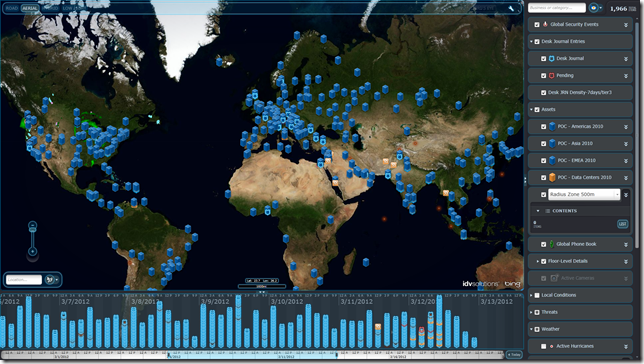Effective information delivery for both proactive and reactive response is one of the most frequent challenges I encounter across our industry. Sharing critical, real-time situational awareness is crucial for government agencies, and in particular public safety and law enforcement agencies around the world to succeed at their missions. Something as seemingly simple as linking two data points to a place on a map can provide the puzzle piece that thwarts a terrorist attack or warns a neighborhood in time to evacuate before flash floods hit.
Global corporations can face similar security challenges to those of nations, working to get the right information into the hands of those who can help secure or protect a company. Microsoft has invested heavily in securing our people, our facilities and our assets. Today at the Worldwide Public Safety Symposium, we announced we’re implementing our new data visualization and analysis technology across our three Global Security Operations Centers (GSOCs).

The security processes and cloud computing-based technologies we’re employing are the same that are transforming national security across the globe. To ensure readiness at the local, regional, national and even international levels, many countries have developed information sharing and information fusion centers. Much like Microsoft’s GSOCs, these centers collect, integrate and analyze complex streams of data from multiple partners – national, state, local and tribal governments and the private sector – to create one dynamic common operating picture. Though the size, budgets, infrastructure, security and capabilities of these centers vary widely, their mission is the same: sharing information to protect the public.
The global technological revolution has exponentially increased the data that public safety, law enforcement and related organizations can use. Around the world, many big cities have created amazing mash-ups of video, mainstream media, social media and geospatial systems linked to legacy data stores. Aggregation engines and analytical tools drill through petabytes of data to discover relevant data, which experts share securely at multiple physical and virtual sites.
A constant challenge fusion centers face is extracting more targeted, real-time insight to avoid organizational data overload and to counter evolving, escalating threats, consistent with the guidance set forth by the U.S. Department of Justice (DOJ Guidelines) and other relevant laws worldwide. The DOJ Guidelines are important tools for federal, state, local and private sector parties to ensure that the requirements around important issues such as governance, privacy and civil liberties, and security of data, are maintained. Outside the U.S., governments also need to balance those issues in ways that are consistent with local laws.
We see three critical steps to extracting meaningful insights from the mountains of information that public safety leaders must manage under the DOJ Guidelines:
· Aggregate and standardize massive amounts of disparate sets of both structured and unstructured data.
· Analyze that data using innovative collaborative toolsets that connect the dots to yield real-time, actionable insights and present them in the most intuitive ways possible.
· Disseminate the information products securely to the people that need them, when those people need them, in the simplest and fastest fashion across diverse devices and situations.

This approach reflects industry-wide interest in – and applies Microsoft innovation to – several major technologies that are revolutionizing our ability to yield faster actionable insight: business intelligence (BI), data visualization, cloud computing and geospatial mapping technologies, to name a few. Video and mobile technologies, like the Modularis Mobile Video Platform (MVP), are also transforming the way law enforcement functions. MVP is an in-vehicle video system that provides law enforcement organizations with real-time and archived video of on-street incidents. Commanders at headquarters can pinpoint GPS-equipped vehicles’ location via mapping technologies, watch live video feeds, and even remotely operate in-vehicle DVRs.
One recent success story is the Ogden, Utah Police Department, which uses Microsoft Fusion Framework and Fusion Core Solution in its Real Time Crime Center (RTCC). The Fusion Core Solution – which incorporates Microsoft SharePoint Server 2010 and ArcGIS, geospatial mapping software from longtime Microsoft partner ESRI – helps law enforcement, counterterrorism agencies and the Ogden PD improve information management, information sharing and overall effectiveness. For example, senior Ogden PD officers can supply real-time Geographic Information Systems maps layered with arrest histories, unserved warrants and other relevant data before patrol officers arrive on scene, increasing officer safety and effectiveness and reducing call handle times.
Located in Redmond, Wash.; Reading, United Kingdom; and Hyderabad, India, the three GSOCs help protect the safety and security of Microsoft’s 160,000 employees and contractors at 700 facilities in more than 100 countries. IDV Solutions’ Visual Command Center integrates gigabytes of data each second from multiple internal security systems and external data feeds around the world, uniting them in a dynamic, common operating picture that helps Microsoft Global Security make more informed decisions, coordinate responses, and even save lives.

